16 – July 2019
clustered | unclusteredArea X – The Southern Reach Trilogy: Annihilation, Authority & Acceptance
Jeff VanderMeer

a
clustered | unclusteredWeird Shimmers
Marco Caracciolo1
If we speculate, as many scholars do, that the weird as a literary mode is particularly well suited to capturing today’s Anthropocenic realities, we may wonder: what are the formal aspects or elements that give the weird purchase on the entanglement of human societies and nonhuman processes that defines the Anthropocene?2 To begin answering that question, I draw inspiration from one of the ways in which Alex Garland’s film adaptation of Annihilation departs from Jeff VanderMeer’s novel.3 The contaminated region known as “Area X” in the novel becomes “the Shimmer,” the invisible border turns into an iridescent surface that recalls a soap bubble or an oil film (see Figure 1). The technical term for this phenomenon is “thin-film interference”: in looking at a film of a viscous substance, the colors we perceive are unstable, they change with the angle of our gaze (see Figure 2). This unstable perception is determined by the physical structure of the film, which intensifies some wavelengths and attenuates others. Thin-film interference is also what creates the bright coloration of, for instance, the wings of a Morpho butterfly (see Figure 3). The butterfly’s iridescent blue is not a matter of pigmentation (of chemicals physically present in the wings) but depends on the light-interacting properties of the wings’ scales: “The structure, instead of a chemical, creates the color.”4
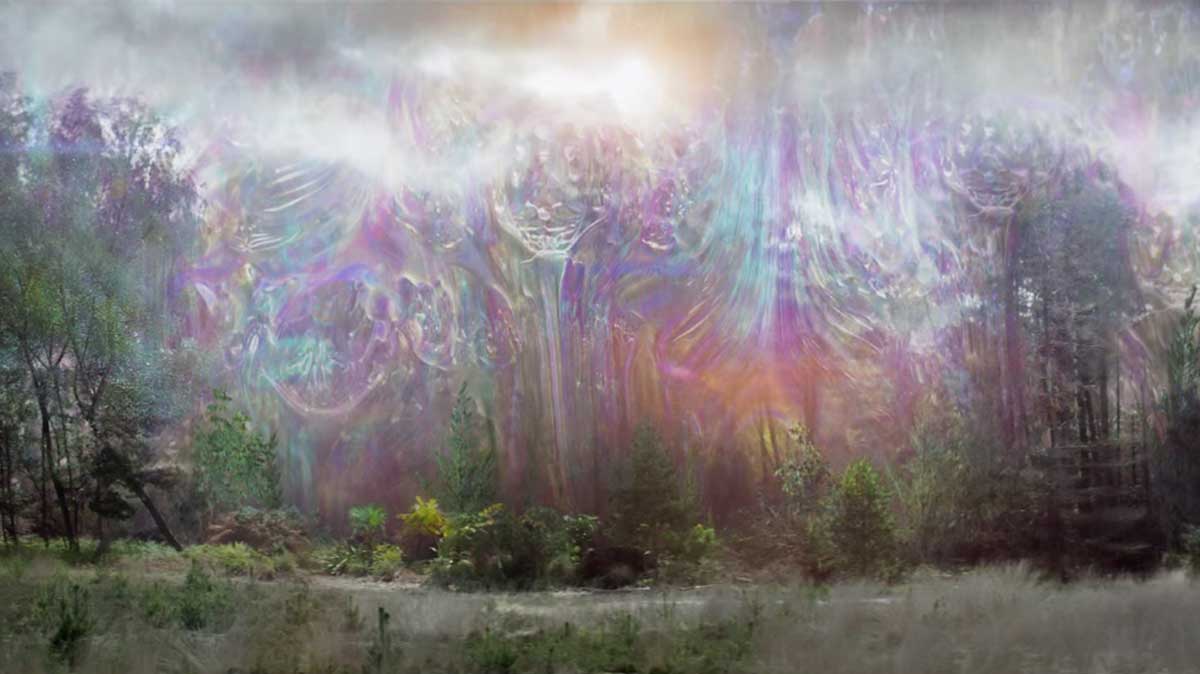


Such iridescence is a powerful visual manifestation of the slipperiness of the weird as a concept, and of how weird fiction—as noted by Roger Luckhurst—tends to veer from one “horizon of expectation” to “another.”5 More specifically, because iridescence is a structural quality, it becomes an apt metaphor to discuss the formal underpinnings of the weird. That Garland’s film had to resort to this visual effect, while VanderMeer’s novel sticks with the more conventionally named “Area X,” is a testament to the different formal affordances of cinema and prose fiction. But VanderMeer’s works, and weird fiction more generally, are also rich in unstable shimmers, as I will try to demonstrate. And just as in oil films and butterfly wings, the iridescence of weird fiction is a structural property—in this case, it mirrors the interlocking structure of narrative and of readers’ imagination. While iridescence as a metaphor privileges visuality, weird fiction makes use of other sensory modalities as well to convey perceptual and conceptual instability—indeed, elsewhere I’ve analyzed the haptic strategies at work in the Southern Reach trilogy, particularly through the recurring motif of the “living wall.”6
The language of shimmering and iridescence emerges in two other contexts that can be productively brought to bear on the account of the weird I am developing. Both sources are tightly linked to contemporary debates on the Anthropocene—respectively, via the foregrounding of affect and the exploration of non-Western (Indigenous) perspectives on the natural world. The first of these sources is Melissa Gregg and Gregory Seigworth’s introduction to the Affect Theory Reader, a chapter titled “An Inventory of Shimmers.”7 The image of the shimmer comes from a late lecture series by Roland Barthes, as Gregg and Seigworth point out.8 Barthes’s lectures revolve around “the neutral,” a category that defies structuralist dichotomies and instead calls for the scalar language of intensity, which Barthes repeatedly compares to a “shimmer.” “The Neutral—Barthes writes—is the shimmer: that whose aspect, perhaps whose meaning, is subtly modified according to the angle of the subject’s gaze.”9 Likewise, Gregg and Seigworth’s version of affect theory requires “accounting for the progressive accentuation (plus/minus) of intensities, their incremental shimmer: the stretching of process underway, not position taken.”10 The view of structure brought out by this discussion is dynamic, unstable, and inherently affective rather than modeled on the strictly binary and conceptual logic of structuralism. This processual understanding of structure underlies my account of weird shimmers as they arise at the intersection of textual strategies and the reader’s imagination.
For a second emergence of the language of shimmers, we can turn to Wild Dog Dreaming by anthropologist Deborah Bird Rose.11 This book can help us close the gap between iridescence as a visual phenomenon and broader discussions on the value of art in the Anthropocene. Based on extensive fieldwork with Aboriginal people in Northern Australia, Rose develops a philosophy—and more specifically an ethics—geared towards the challenges of living in times of ecological crisis. From this perspective, which Rose calls “ecological existentialism,” it is crucial to realize that life and death constitute the basic pattern of reality; ethical responsibility flows from an insight into their inseparability: “To live in the world, to live in connectivity, is always to be living in proximity to death as well as to life, to cause death as well as to nurture life.”12 For Rose, iridescence and shimmering are the structural form of that connectivity.
We can trace the work of metaphorical language in Rose’s discussion and how it leads to this description of the connectivity of life and death as iridescent. Rose first draws inspiration from ethnomusicologist Cath Ellis’s account of Aboriginal music: “Ellis describes Aboriginal music as ‘iridescent.’ She explains this unexpected concept with reference to the phenomenon that occurs when background and foreground suddenly flip.”13 That of the “flip” is, of course, a kinetic metaphor that allows Rose to capture the unstable auditory patterning of Aboriginal music. Later, similar language is used to describe Aboriginal dance: “In the performance of [Aboriginal] ceremony, there are many flips. For the dancer there is the flip between the feet on the ground and the ground on the feet: Who is the dancer, and who is the danced? If we focus on motion, it is clear that both are dancer and danced, and that the significance of this mutuality is located in the flip back and forth.”14 The motion blurs the physical contour of the dancer’s body, fusing them with the nonhuman “ground” and with an abstract pattern of motion.
To specify the link between this flip and iridescence, Rose adds: “Flips appear at first to be either/or: either this foreground or that foreground. But for participants, the patterns are experienced in the body and in time. One is experiencing both flow and simultaneity, and iridescence arises in the patterns of mutual copresence. Iridescence is the point at which the either/or is experienced as both/and.”15 Rose’s final move is to translate that flip, or that iridescence, into a philosophy of ethical connectivity: “In thinking about life and death, we encounter just such an iridescence, a shimmer arising from Earth life. Time and multiplicity move us into flow. In terms of multiplicity, all living beings are in motion, coming or going, from place to place and from life to life.”16 Note that, while the ecological crisis is an inherently unstable time—a time of “bumpiness,” in William Connolly’s terminology—the instability and uncertainty of our future are typically seen as the dramatic disruption of a human order and thus shot through with negative feelings of fear and dread.17 The connectivity Rose talks about is also fundamentally volatile and precarious, but its instability—Rose suggests—has to be embraced rather than feared. The metaphorical language of iridescence helps make that affective shift from dread to acceptance by associating instability with aesthetic patterning—an extension, if you will, of the attractive iridescence found in soap bubbles or butterfly wings. To put the same point another way: there is a pleasure to instability, a pleasure iconically captured by multistable figures such as the famous Rubin vase of Gestalt psychology (see Figure 4). Ecological existentialism seeks to cultivate that pleasure, and art—such as Aboriginal music and dance in Rose’s discussion—has a central role to play in fostering it.

Hence my key claim in this paper: weird fiction is attuned to the Anthropocene because it is structurally at ease with unstable flips and shimmers, which are not merely the external events that make up the plot but ontological instabilities that become entangled in the texture of the characters’ (and potentially also readers’) subjectivity. I will demonstrate that idea by discussing a few passages by VanderMeer and by another contemporary author often aligned with the weird, Jonathan Lethem; but I think it would be possible to extend that analysis to other contemporary writers who make use of the weird as a literary mode.18
The Rubin vase, which I just mentioned, recalls the shape-shifting nature of the eponymous protagonist of VanderMeer’s Borne. This character has no fixed shape but can take multiple physical forms, including, in what seems to be a default form, a “vase” or “squid” pose that strongly evokes Rubin’s optical illusion.19 Early in the novel, we read that “the creature I called Borne had retreated into itself but had now, with a strangely endearing tentative grace, become vase-shaped again. The thing just lay there on the table, pulsing and strobing in a way I found comforting. The strobing made it look bigger, or perhaps it had already started growing.”20 Borne’s physical “pulsing and strobing” is closely related to shimmering, of course: these are verbal figures of productive, and “strangely endearing,” instability, and they ripple through the reader’s mental imagery as we try to visualize this elusive character.
Mental images, as Elaine Scarry shows in Dreaming by the Book, are inherently delicate and impalpable—“gauzy” or gauze-like is Scarry’s favorite analogy.21 VanderMeer’s descriptions deepen this impalpability through linguistic references that emphasize the fluidity of Borne’s shape, eliciting mental imagery in which “background and foreground suddenly flip,” to quote Rose again. Crucially, this is no simple, on-off flip, as in the Rubin illusion where we either see a vase or two faces. This is also no mere tower/tunnel hesitation, as in the unstable spatiality of the Southern Reach, which retains a binary quality. Rather, in imagining Borne the contours of our mental imagery are volatile, clinging to known shapes like “vase” or “squid” only to be radically reconfigured as the character’s form evolves. This iridescence doesn’t emanate from fixed structure but from dynamic structuration as Gregg and Seigworth discuss it (via Barthes); it emerges from the reader’s encounters with VanderMeer’s stylistic choices.
Similarly, in Acceptance, the third volume of the Southern Reach trilogy, the biologist turns into a monster whose nature flickers between a creature and the physical landscape: “How the biologist coalesced out of the night, her body flickering and stitching its way into existence, in the midst of a shimmering wave that imposed itself on the reality of forested hillside. The vast bulk seething down the hill through the forest with a crack and splinter as trees fell to that gliding yet ponderous and muffled darkness, reduced to kindling by the muscle behind the emerald luminescence that glinted through the black.”22 It is exceedingly difficult to visualize this monstrous body, or to position it against a stable background of natural phenomena. In this way, VanderMeer’s prose enacts in sensory terms Timothy Morton’s insight that since “everything is interconnected, there is no definite background and therefore no definite foreground.”23 This is an effect of the iridescence—of the textual description, but also potentially of the reader’s imagination.
In Lethem’s novel Amnesia Moon (1995) we find a similar instance of radical instability, but spread out over an entire storyworld. The novel is set in a by now familiar postapocalyptic wasteland; what makes this landscape less familiar is that the nature of the disaster keeps changing, depending on where you are and who you ask. In rural Wyoming, where the novel begins, everyone seems to have forgotten what the world was like before the catastrophe. The protagonist is a character whose name is in itself unstable (he is variously known as Everett, Moon, and Chaos); as he drives to California, he encounters various versions of the catastrophe: a small town is surrounded by a mysterious green fog; here, we find out, the “Earth’s atmosphere opaqued. Then, for a short time, they called it the bloom. As though the sky itself had grown moldy. But soon everyone called it what most had called it at the very beginning: the green.”24 Elsewhere, people deny that the disaster ever happened, while in Southern California a UFO invasion is taking place. As one of the characters remarks, “You know, the weirdness came out, that’s all. It’s not like it wasn’t always there. Things got all broken up, localized.”25 This idea of “localized weirdness” becomes the hallmark of a novel that engages in constant “flips” between reality, hallucination, and dream experience: catastrophe involves a warping of the fabric of human subjectivity, because natural events are always already internal and psychological, even if post-Cartesian thinking in the Western world has tended to erect a barrier between these domains of reality.26
Read in this way, the formal instability of Borne, the biologist’s “vast bulk,” or Lethem’s fluctuating catastrophe become figures for the life-and-death connectivity described by Rose. Just as life is intrinsically entangled with death, Borne “was kind and sweet and curious, and yet could not stop killing.”27 This realization is dynamically inscribed in weird fiction through the shimmering effects and unstable affects of VanderMeer’s and Lethem’s language, where the monstrous, the cute, the sublime, and the ridiculous are repeatedly conflated.
From this perspective, weird shimmers recall the structural hesitation of Tzvetan Todorov’s fantastic, with one key difference: for Todorov, the fantastic wavers between realism and the marvelous; in the weird mode, by contrast, the wavering is never a binary structure, but multistable structuration.28 My final proposition is that the value of the weird as a response to the Anthropocene lies in the power of its formal shimmers: the power, that is, to confront the reader, in highly embodied, visceral terms, with the material and affective instability of the mesh that enfolds human and nonhuman realities. Weird fiction, or at least sophisticated weird fiction like VanderMeer’s or Lethem’s, offers training in radical instability; repeated exposure to the weird promises to deepen the reader’s understanding of and tolerance for the iridescent connectivity of the Anthropocenic world we live in.
Notes
- 1While working on this article the author received funding from the European Research Council (ERC) under the European Union’s Horizon 2020 research and innovation program (grant agreement no. 714166).
- 2See, e.g., Roger Luckhurst, “The Weird: A Dis/Orientation,” Textual Practice 31, no. 6 (2017): 1041–61. For Luckhurst, the “focus of weird writing on unnerving edgelands . . . suggests that it is a fiction that is not so much an ecological literature as a form peculiarly suited to addressing the hybrid world of the Anthropocene” (1056). For more on the Anthropocene and the entanglement of human and nonhuman histories, see Dipesh Chakrabarty, “The Climate of History: Four Theses,” Critical Inquiry 35, no. 2 (2009): 197–222.
- 3Jeff VanderMeer, The Southern Reach Trilogy 1: Annihilation (New York: Farrar, Straus and Giroux, 2014); Alex Garland, Annihilation (Paramount Pictures, 2018).
- 4“Wing Scales Cause Light to Diffract and Interfere,” AskNature (blog), accessed April 5, 2019, https://asknature.org/strategy/wing-scales-cause-light-to-diffract-and-interfere/.
- 5Luckhurst, “The Weird: A Dis/Orientation,” 1050.
- 6Marco Caracciolo, “Narrative Form and the Texture of Catastrophe” (The Apocalyptic Dimensions of Climate Change and Fluctuating Environments in Scientific Models and Cultural Discourses, RWTH Aachen University, 2018).
- 7Melissa Gregg and Gregory J. Seigworth, “An Inventory of Shimmers,” in The Affect Theory Reader, ed. Melissa Gregg and Gregory J. Seigworth (Durham: Duke University Press, 2010), 1–25.
- 8Roland Barthes, The Neutral, trans. Rosalind E. Krauss and Denis Hollier (New York: Columbia University Press, 2005).
- 9Barthes, The Neutral, 51.
- 10Gregg and Seigworth, “An Inventory of Shimmers,” 10–11.
- 11Deborah Bird Rose, Wild Dog Dreaming: Love and Extinction (Charlottesville: University of Virginia Press, 2011). Rose further develops the “shimmer” metaphor in “Shimmer: When All You Love Is Being Trashed,” in Arts of Living on a Damaged Planet, ed. Anna Tsing et al. (Minneapolis: University of Minnesota Press, 2017), G51–63.
- 12Rose, Wild Dog Dreaming, Kindle Locations 2577-2584.
- 13Rose, Wild Dog Dreaming, Kindle Location 2479.
- 14Rose, Wild Dog Dreaming, Kindle Location 2487.
- 15Rose, Wild Dog Dreaming, Kindle Location 2495.
- 16Rose, Wild Dog Dreaming, Kindle Location 2499.
- 17William E. Connolly, Facing the Planetary: Entangled Humanism and the Politics of Swarming (Durham: Duke University Press, 2017).
- 18On Lethem and the weird, see Luckhurst, “The Weird: A Dis/Orientation,” 1050.
- 19See, e.g., Jeff VanderMeer, Borne (New York: Farrar, Straus and Giroux, 2017), 186.
- 20VanderMeer, Borne, 10.
- 21Elaine Scarry, Dreaming by the Book (Princeton: Princeton University Press, 2001).
- 22Jeff VanderMeer, The Southern Reach Trilogy 3: Acceptance (New York: Farrar, Straus and Giroux, 2014), 193–94.
- 23Timothy Morton, The Ecological Thought (Cambridge, MA: Harvard University Press, 2010), 28.
- 24Jonathan Lethem, Amnesia Moon (Orlando: Harcourt, 1995), 44.
- 25Lethem, Amnesia Moon, 60.
- 26For more on literary engagements with catastrophe and its psychological and ethical ramifications, see Kate Rigby, Dancing with Disaster: Environmental Histories, Narratives, and Ethics (Charlottesville: University of Virginia Press, 2015).
- 27VanderMeer, Borne, 314–15.
- 28Tzvetan Todorov, The Fantastic: A Structural Approach to a Literary Genre, trans. Richard Howard (Ithaca and London: Cornell University Press, 1975).
b
clustered | unclusteredTurning Away from the Edge of Madness: Kinesis, Nihilism, and Area X
Kaisa Kortekallio
In Energy and Experience: An Essay in Nafthology, philosophers Antti Salminen and Tere Vadén make a radical claim: the modern Western form of subjective experience, with its separation of mind and matter, is only made possible by the energetic power of easily accessible fossil fuels. In their materialist analysis, experiencing oneself as an individual standing aloof from human and nonhuman others is a phenomenon arising from the general availability of cheap oil, and the particular economic and social relationalities cheap oil enables.1
If we entertain this idea, then we must also admit that once the energetic base shifts from fossil fuels to something else, other patterns of subjective experience will replace fossil subjectivity. As the energetic ground shifts, everyday experience becomes suspect: what is there, in my habitual engagements with my surroundings, that repeats fossil patterns? What else is beginning to take shape? Could engagement with New Weird fiction allow me to feel the faint, rising rhythm of post-fossil experience? Maybe New Weird, through its unconventional treatment of nonhuman monstrosity, can allow me to unsettle some fossilized sediments of feeling.
Contemporary cognitive science and biology present human bodies as both nonconscious and nonhuman. Consciousness is grounded in and continuously shaped by a nonconscious buzz of metabolic and cognitive events. Some, such as microbial processes, are decidedly nonhuman. Our responses to the movements of other bodies (human and nonhuman, actual and fictional) also mostly take place on the nonconscious level. This mode of sense-making is known as kinesis.2 In engaging with narratives involving movement, such as falling, you cannot help but respond, to simulate the movement in your mind as you would when witnessing actual falling. This kind of perceptual and sensorimotor simulation is usually taken for granted, both in everyday reading and in academic analyses, maybe because it is both very basic and very fleeting. However, attending to basic kinesic responses while reading fiction can help us access this level of experience as it unfolds. Careful practice can help bring some aspects of it to conscious access by slowing down and amplifying processes of kinesic sense-making.3
Narratologist Robyn Warhol argues that as our affective responses to narrative patterns become habitual, they participate in our expressive styles: in our behaviour, we echo the feelings and gestures familiar to us from fiction. In a very literal sense, fictional bodies live with us and shape our patterns of feeling and perception.4 These patterns often tie into the bodily styles of fictional characters—which, in turn, perform their choreographies according to their own conventions and constraints. In this bodily and partly nonconscious way, the conventions of contemporary fiction can be seen to participate in the production of modern—or fossil—subjectivity.
Horror fiction and Old Weird fiction contain fictional choreographies that have become highly conventionalized; they are fodder for creative variation in contemporary genre-conscious narratives. As New Weird repurposes these patterns, opportunities for experiential change open up for the reader. Jeff VanderMeer’s Southern Reach trilogy, especially, has been lauded as fiction that mixes influences to reimagine nonhuman otherness.5 Previous research has argued that the trilogy provides models for moving beyond the fear of the unknowable and “allows the reader to eventually experience radical alterity as something other than merely destructive.”6 Kinesic reading helps us zoom in on how this experientiality unfolds in the act of reading. I build on George J. Sieg’s notion of the “Gnostic victim” of horror to demonstrate how Annihilation, the first book of the trilogy, mobilizes and reconfigures the corporeal model of the Lovecraftian victim, and, in particular, the protagonist’s encounter with the monster. Analyzing this encounter shows how the novel estranges habitual patterns of feeling horror at the face of the unknowable, and perhaps nudges the reader toward a more-than-human organization of feeling.
Hovering on the Edge
Staging an encounter between the biologist-protagonist and the nonhuman unknowable, Annihilation presents a detailed choreography of sensorimotor and epistemic uncertainty. We can begin here, on the edge of a tidal pool, and trace the fictional figure of the biologist throughout the novel to the edge of human experience, beyond which we cannot follow her:
What I found when I finally stood there, hands on bent knees, peering down into that tidal pool, was a rare species of colossal starfish, six-armed, larger than a saucepan, that bled a dark gold color into the still water as if it were on fire. Most of us professionals eschewed its scientific name for the more apt “destroyer of worlds.” ... I had never seen a destroyer of worlds before, even in an aquarium, and it was so unexpected that I forgot about the slippery rock and, shifting my balance, almost fell, steadying myself with one arm propped against the edge of the tidal pool.
But the longer I stared at it, the less comprehensible the creature became. The more it became something alien to me, the more I had a sense that I knew nothing at all—about nature, about ecosystems. There was something about my mood and its dark glow that eclipsed sense, that made me see this creature, which had indeed been assigned a place in the taxonomy—catalogued, studied, and described—irreducible down to any of that. And if I kept looking, I knew that ultimately I would have to admit I knew less than nothing about myself as well, whether that was a lie or the truth. When I finally wrenched my gaze from the starfish and stood again, I could not tell where the sky met the sea, whether I faced the water or the shore. I was completely adrift, and dislocated, and all I had to navigate by in that moment was the glowing beacon below me.7
The biologist has arrived on these slippery coastal rocks at the end of a drunken and disoriented evening. The passage makes it easy for the reader to enact the location, posture, and movements of the narrator’s body: we imagine her as standing, “hands on bent knees, peering down into that tidal pool” and then shifting her balance and almost falling, ending up perched awkwardly against the edge of the pool.
As we do this, we also enact the bodily feelings and cognitive trajectories woven into the narration. Seeing, the primary means of epistemic control, turns into futile staring that yields no result: “the longer I stared at it, the less comprehensible the creature became.” The strangeness of the starfish grows to encompass nature and ecosystems, and “something in [the biologist’s] mood and in its dark glow” makes the starfish seem irreducible to scientific knowledge. The kinetic action in the passage further emphasizes this failure in understanding—the biologist fails to keep her balance, and she fails to make sense of the starfish.
In the last sentences of the passage, perception, emotion, and sense-making come together in an encompassing sense of disorientation that is mapped in spatial terms: the biologist is “completely adrift, and dislocated.” This fictional experience conveys the disorientation of not just a skull-bound mind but an entire lived body.
In the pages that immediately follow, the biologist recounts “a similar experience at a thousand times the magnitude”: the encounter with the monster that writes the spore-emitting words on the wall of the tower/tunnel.8 This encounter involves a psychedelic confusion of sensory impressions, starting with a “blue-green light [that] was like nothing I had experienced before [and] so overwhelmed my ability to comprehend shapes within it that I forced myself to switch from sight, to focus at first on reports from other senses.” This vision is accompanied by an “unearthly noise [that] had a texture and a weight, and with it came a burning smell, as of late fall leaves or like some vast and distant engine close to overheating.” In her retrospective commentary of this description, the biologist admits that the particular details might have been produced in the act of remembering: “It is difficult to tell what blanks my mind might be filling in just to remove the weight of so many unknowns.” In this way, the narrative leaves a door open to the irreducible mystery of the perceptual event while simultaneously providing very detailed and rich description.
Like the encounter with the starfish, the encounter with the monster brings the biologist to the limits of her perceptual and cognitive abilities. In her perception, the shape of the monster keeps changing, evoking optical illusions and impossible sensations. This perceptual uncertainty leaves her in an all-encompassing feeling of existential insecurity.
What can you do when your five senses are not enough? Because I still couldn’t truly see it here, any more than I had seen it under the microscope, and that’s what scared me the most. Why couldn’t I see it? In my mind, I stood over the starfish at Rock Bay, and the starfish grew and grew until it was not just the tidal pool but the world, and I was teetering on its rough, luminous surface, staring up at the night sky again, while the light of it flowed up and through me.9
The motif of staring without comprehension, combined with an unsteady balance characterized as “teetering,” is repeated again. The luminous starfish of the biologist’s imagination grows in size and sends its light to join the light of the night sky, leaving the biologist in between these two incomprehensible entities, permeated by light.
Reading through these fictional situations, I am prompted to enact uncomfortable bodily feelings of losing full vision and balance despite my efforts to maintain them. While the detail of description provides abundant sensory cues, some of them beautiful (blue-green light) and some frightening (burning smell, overheating engine), the abundant detail mainly serves to add complexity to the basic bodily feeling of failing to maintain sensorimotor control. And as sensorimotor control is precisely the bodily ability that, in enactivist theory and phenomenology of the body more broadly, maintains our sense of a stable self, the bodily feeling of losing that control serves to temporarily undermine coherent subjectivity itself.10
By evoking the destabilization of the lived body, the novel also effectively articulates more conceptual failures in control. Discussing this encounter on a conceptual level demonstrates how kinesis participates in our thematic interpretations of literature and thus adds a level of processual analysis to previous readings provided by Prendergast, Ulstein, and Idema. For the kinesic process, it makes no difference whether the fictional motions are perceived as literal or figurative—and as George Lakoff and Mark Johnson among others have argued, our embodied understanding of both concepts and language often follows a figurative logic.11
Cognitivist Nihilism and the Gnostic victim
The two linked encounters with the starfish and the monster form a sublime scene, beginning from the mundane observations of the biologist but growing beyond them into cosmic existential dread. For a moment, it seems like the novel repeats a pattern familiar from an older style of weird and horror fiction—the protagonist finds the edge of her comprehension, and is forced to stay there, succumbing into madness. It seems there is no option other than a final fall from the edge—a kind of nihilism or annihilation of the perceiving rational subject. A closer look at both the rendering of the encounters and the notion of nihilism, however, shows that this would be a hasty conclusion.
A key text in the enactivist approach to cognition, The Embodied Mind, defines nihilism in Nietzschean terms: “the nihilistic predicament is the situation in which we know that our most cherished values are untenable, and yet we seem incapable of giving them up.”12 In the specific context of contemporary cognitive science discussed by Varela and his coauthors, this predicament ties into the hopeless cognitivist attachment to consciousness and free will. Cognitivist nihilism involves both the realization that science does not support the existence of a central, conscious, masterful self, and the persistent inability to think of human experience without such a notion.13 The Embodied Mind presents nihilism as incapable of coming to terms with the groundlessness at the heart of both Western science and subjective experience: enactive cognition is metaphysically “groundless,” as it cannot be traced back to a stable foundation in either a pre-given world or a permanent self. Using robustly corporeal terms, Varela, Thompson and Rosch claim that a realization of this view
initially results in a sense of vertigo due to the collapse of what we had supposed to be sure and stable foundations. But rather than sweeping this sense of groundlessness under the rug by once again pitching the internal and the external against each other . . . we need to delve deeper into [it] and follow through all of its implications, philosophically and experientially.14
As discussed above, the “sense of groundlessness” as a bodily feeling, figures prominently in VanderMeer’s Southern Reach trilogy, and moments of characters losing their balance occur at thematically crucial moments. VanderMeer’s fiction thus provides opportunities for “following through” the implications of groundlessness in terms of both theme and readerly experience and move beyond nihilism.
Cognitivist nihilism becomes more tangible when we bring in the tradition of Weird fiction, and the work of H.P. Lovecraft in particular. George J. Sieg argues that Lovecraftian horror emerges from the experience of the victim’s perception and reason being violated. Lovecraft’s characters are “stripped down to being bare instruments of perception . . . impaled by an intrusive, inescapably bizarre alien otherness.”15 Sieg calls this mode of focusing on perception and conception “Gnostic horror,” and finds it throughout the history of horror fiction, ranging from classic vampire fiction to the Exorcist films. Moreover, he locates Gnostic horror in the perspective of the victim rather than in the presence or characteristics of the monster. The victim, whether the virginal heroine ravished by demonic forces or the pure-minded scientist driven mad by eldritch horrors, needs to be “innocent, as regards the horror.”16 In Sieg’s analysis, the innocence of Lovecraftian victims is tied to their supposedly secure position as rational, sane, white and Aryan subjects—forced to encounter a world of reason-defying miscegenated monstrosities. The Gnostic victim thus performs the cognitivist nihilist choreography of hovering at the edge of the unknowable, helplessly staring into the monstrous abyss.
Returning to Annihilation, we can ask whether the encounter of the biologist and the monster fits into the dualist horror schema characterized above as cognitivist nihilism and embodied in the Gnostic victim. We already saw how the scene destabilizes sensorimotor control and the reliability of perception. However, it seems to map rationality and subjectivity in a way that differs from the cognitivist nihilist pattern. The biologist continues to observe the monster even when her sight fails her, focusing at first “on reports from other senses.” Even when those reports appear as confusing and potentially misleading, as she admits that her mind might be making up the details, the narration retains a calmness detached from the perceptual confusion.
Moreover, the biologist rationally recognizes that the monster is an organism with strange but partially comprehensible abilities, and thus contextualizes the monster as part of the ecosystem of Area X. In this ecological mode of thought and experience, she accepts the unknowability of the monster. Thus, even when limited rationality might be necessary for the coherence or continuity of her subjectivity, total epistemic control is not—she does not succumb to madness. In this regard, the character of the biologist differs from the tradition of Gnostic victims.
Sieg concludes that for Lovecraft, “there was no solution or escape from the horror, as becoming the monster through deliberate identification is hardly an option for the extreme reductionist. For him, life is a conceptual nightmare with only the void of an empty consciousness as contrast.”17 But Sieg’s analysis inadvertently provides a conceptual way out of horror: relinquishing purity and becoming monstrous. Gry Ulstein’s and Finola Anne Prendergast’s analyses suggest that this is exactly what happens in the Southern Reach trilogy. As Ulstein puts it, the trilogy presents the monstrous as “a potentially emancipatory catalyst for starting to think in weird terms.”18
Weird terms, in the case of the biologist, can also be interpreted as ecological terms. Even before entering Area X, she is open to the notion of ecological interdependency—in fact, she cannot figure herself outside of such relationality. She figures herself as an expression of her environments. This anti-individualism marks her as not “innocent, as regards the horror,” as a proper Gnostic victim would be. In a move that finalizes the corporeal choreography of resisting cognitivist nihilism, she closes her eyes and turns away from the monster.
This move—literal to the nonconscious system of readerly response, literal and figural to a conscious critical mind—reconfigures the trope of the Gnostic victim. As the biologist turns away from the edge of madness, the reader performatively enacts the movement and accepts, on the level of nonconscious kinesic response at least, the cognitive reorientation entailed in it. The move now exists as a possible response to encountering monstrosity. The turn can by no means be read as a victory of the masterful human subject, as the monster still forces the biologist through an excruciating near-death experience, and after leaving the tunnel she is gradually transformed into something nonhuman. But even after all this, there is no complete annihilation of the perceiving subject: the biologist “[endures] beyond the endurable.”19 The narrative maintains a pragmatic, reporting tone, and the biologist goes on living and exploring an area that supports monstrous beings as part of its common ecology. The latter parts of the trilogy take this trajectory further, with Acceptance in particular focusing on life in a strange and dangerous ecosystem.
Conclusion: Groundlessness and Ecological Experience
Tom Idema connects the radical epistemological and existential uncertainty of the Southern Reach trilogy to the postmodernist novels of J.G. Ballard, Thomas Pynchon, and Don DeLillo, claiming that the trilogy shares with them “a discrepancy between an unrelenting desire for truth and authenticity, and a structural inability to find it, an inability that the protagonist can barely fathom.”20 In contrast to the postmodernists, Idema argues, VanderMeer renders this discrepancy not only as a social and scientific condition but also as an environmental-posthumanist issue. He builds on contemporary research in ecology to claim that the continuous transmutations of ecosystems are philosophically just as radically unknowable as VanderMeer’s Area X. Groundlessness could thus be mapped as a particularly ecological feeling. I suggest that the sense of vertigo at the edge of weird ecologies marks an ongoing disintegration and reconfiguration of subjectivity. As the masterful, purely human subject quickly loses its viability as a lived condition, fiction begins to sketch and suggest new templates for experience.
The alternative to cognitivist nihilism, as presented in the Southern Reach trilogy, is not a harmonious return to nature. While certain passages of the biologist’s account of her life in Area X do echo Thoreau’s Walden, her attunement is jarred and her daily routines perverse. For decades, she postpones her transformation into monstrous form by inflicting pain on herself. Yet, in the hope that allowing that transformation to happen will open up new vistas of knowledge, she eventually gives in. As the monstrous is presented as something beyond human experience and language, the trilogy offers no first-person perspective on the transformation. Tracing the bodily movements of the biologist thus brings the embodied reader to another edge—not of reason and mastery, but of human forms of experience and narrative.
Notes
- 1Antti Salminen and Tere Vadén, Energy and Experience: An Essay in Nafthology (Chicago: MCM’ Publishing, 2015).
- 2See Guillemette Bolens, The Style of Gestures: Embodiment and Cognition in Literary Narrative (Baltimore: Johns Hopkins University Press, 2012).
- 3For slowing down, see Terence Cave Thinking with Literature: Towards a Cognitive Criticism (Oxford: Oxford University Press, 2016). For amplifying, see Astrida Neimanis, Bodies of Water: Posthuman Feminist Phenomenology (London: Bloomsbury, 2017).
- 4Robyn Warhol, Having A Good Cry: Effeminate Feelings and Pop-Culture Forms (Columbus: Ohio State University Press, 2003).
- 5Jeff VanderMeer, Annihilation (New York: Farrar, Straus and Giroux, 2014).
- 6Finola Anne Prendergast, “Revising Nonhuman Ethics in Jeff VanderMeer’s Annihilation,” Contemporary Literature, Vol. 58, No. 3 (2017), 333-60. Also Gry Ulstein, “Brave New Weird: Anthropocene Monsters in Jeff VanderMeer’s The Southern Reach,” Concentric: Literary and Cultural Studies. March 2017, 71-96; Tom Idema, Stages of Transmutation: Science Fiction, Biology, and Environmental Posthumanism (Abingdon: Routledge, 2019), 31.
- 7VanderMeer, Annihilation, 174-75; ellipsis added.
- 8VanderMeer, Annihilation, 175. All citations in the paragraph from pages 175–76.
- 9VanderMeer, Annihilation, 178; emphases in original.
- 10See Maxine Sheets-Johnstone, The Primacy of Movement (Amsterdam: John Benjamins Publishing, 1999); Evan Thompson, Mind in Life: Biology, Phenomenology, and the Sciences of the Mind (Cambridge, Mass.: Harvard University Press, 2007), 334.
- 11George Lakoff and Mark Johnson, Metaphors We Live By (Chicago and London: The University of Chicago Press, 1980).
- 12Francisco Varela, Evan Thompson, and Elena Rosch, The Embodied Mind: Cognitive Science and Human Experience (Cambridge, Mass.: The MIT Press, 1992), 128.
- 13Thomas Metzinger thoroughly explores the source conflict of cognitivist nihilism in Being No One: The Self-Model Theory of Subjectivity (2003). The conflict is also central to recent popular fiction such as the television series True Detective (written by Nic Pizzolatto, 2014–2017) and science fiction such as Peter Watts’ novels Blindsight (2006) and Echopraxia (2014).
- 14Varela et al., The Embodied Mind, 200.
- 15George J. Sieg, “Infinite Regress into Self-Referential Horror: The Gnosis of the Victim,” Collapse: Philosophical Research and Development, Vol. IV (2009), 30–54. 34. See also Michel Houellebecq, H. P. Lovecraft: Against the World, Against Life (London: Weidenfeld, 2006).
- 16Sieg, “Infinite Regress,” 34; emphasis in the original.
- 17Sieg, ”Infinite Regress,” 53–54.
- 18Ulstein, ”Brave New Weird,” 94.
- 19VanderMeer, Annihilation, 182.
- 20Idema, Stages of Transmutation, 109.
c
clustered | unclusteredEarth
1. The Original Sin
Flor Maesen

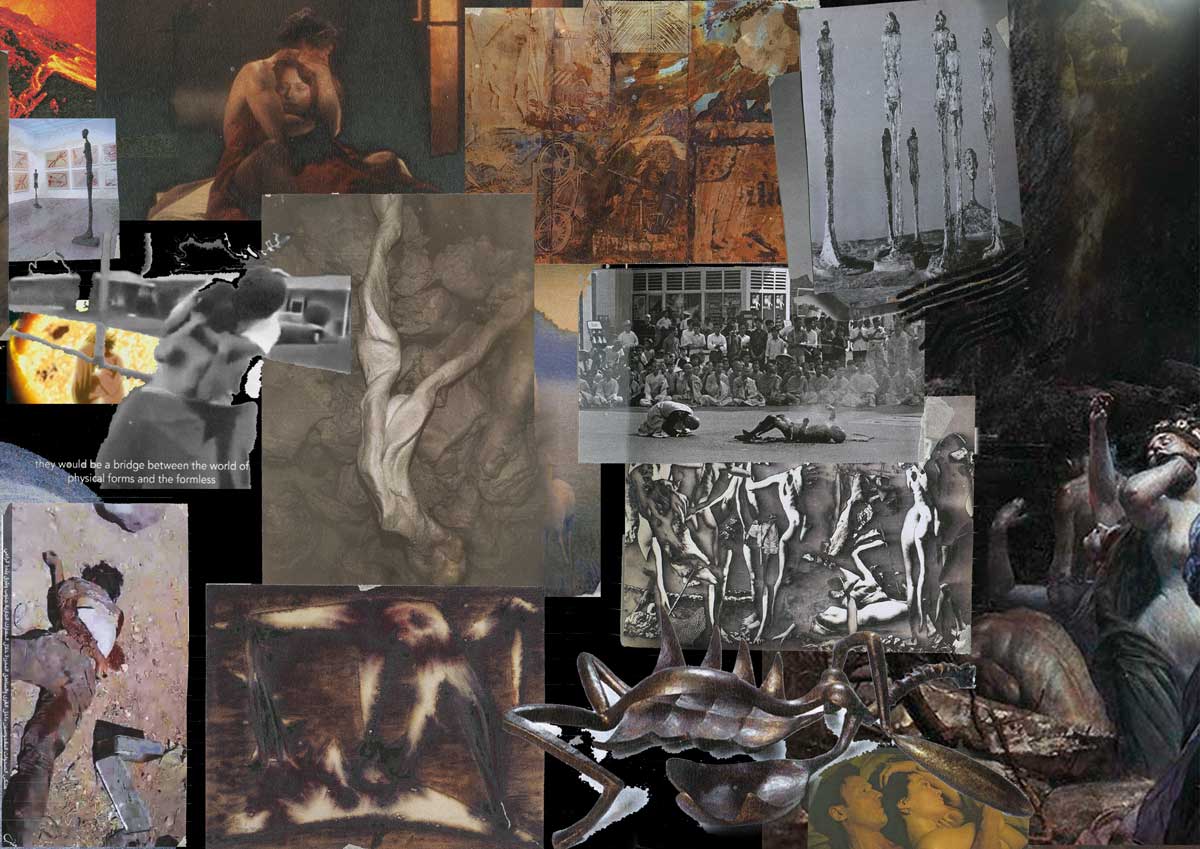
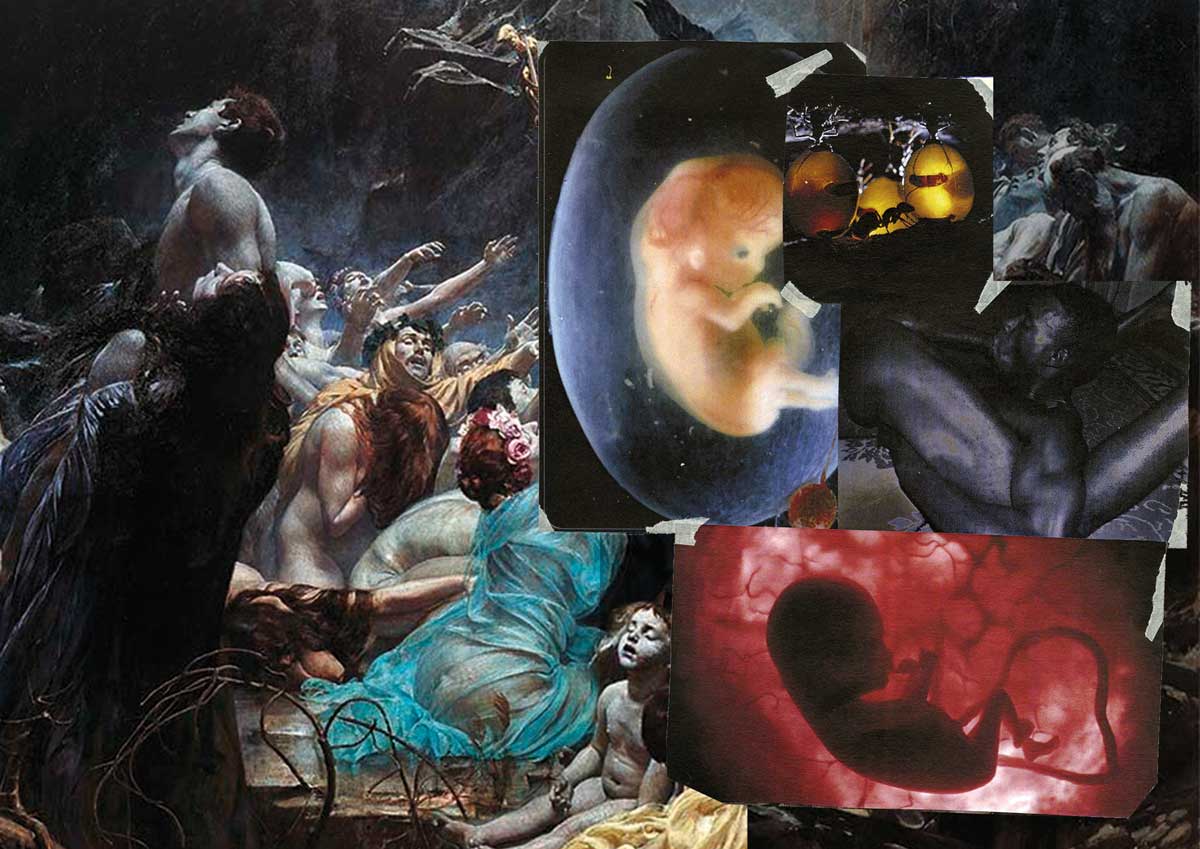


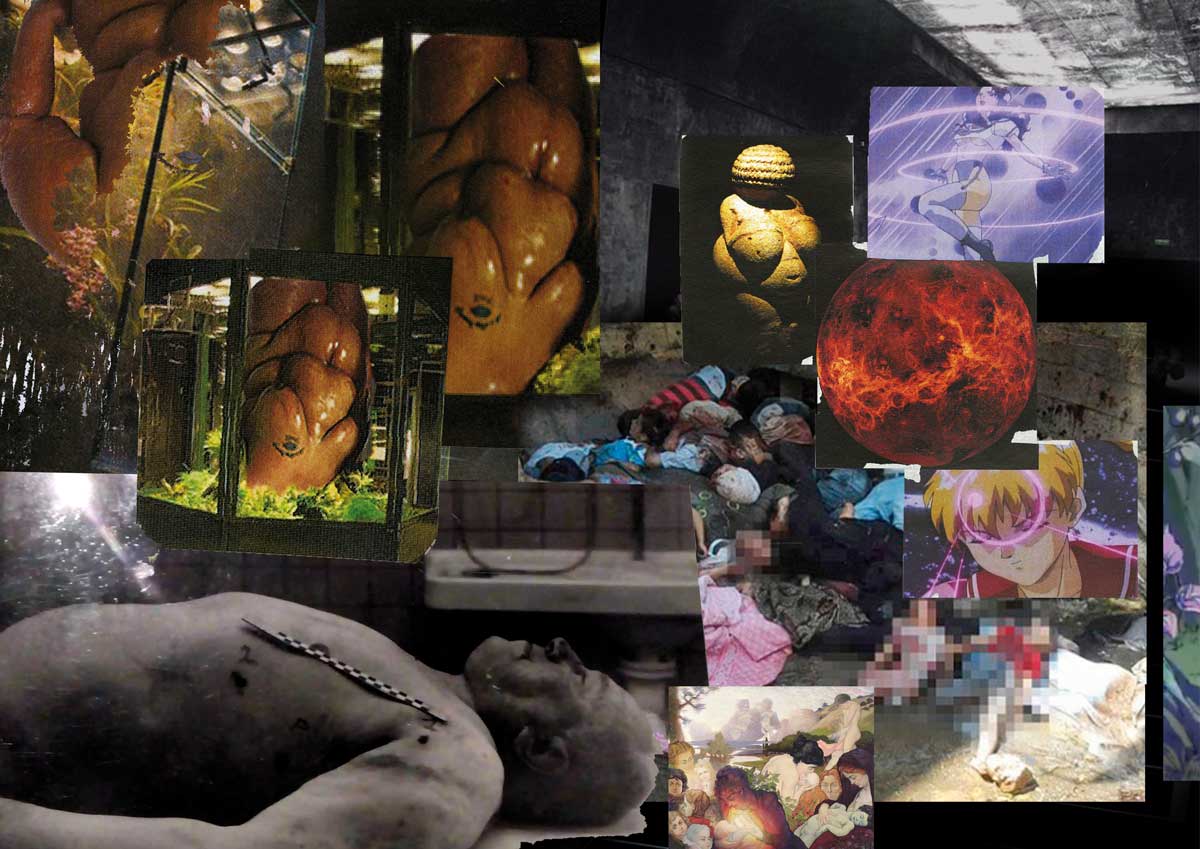

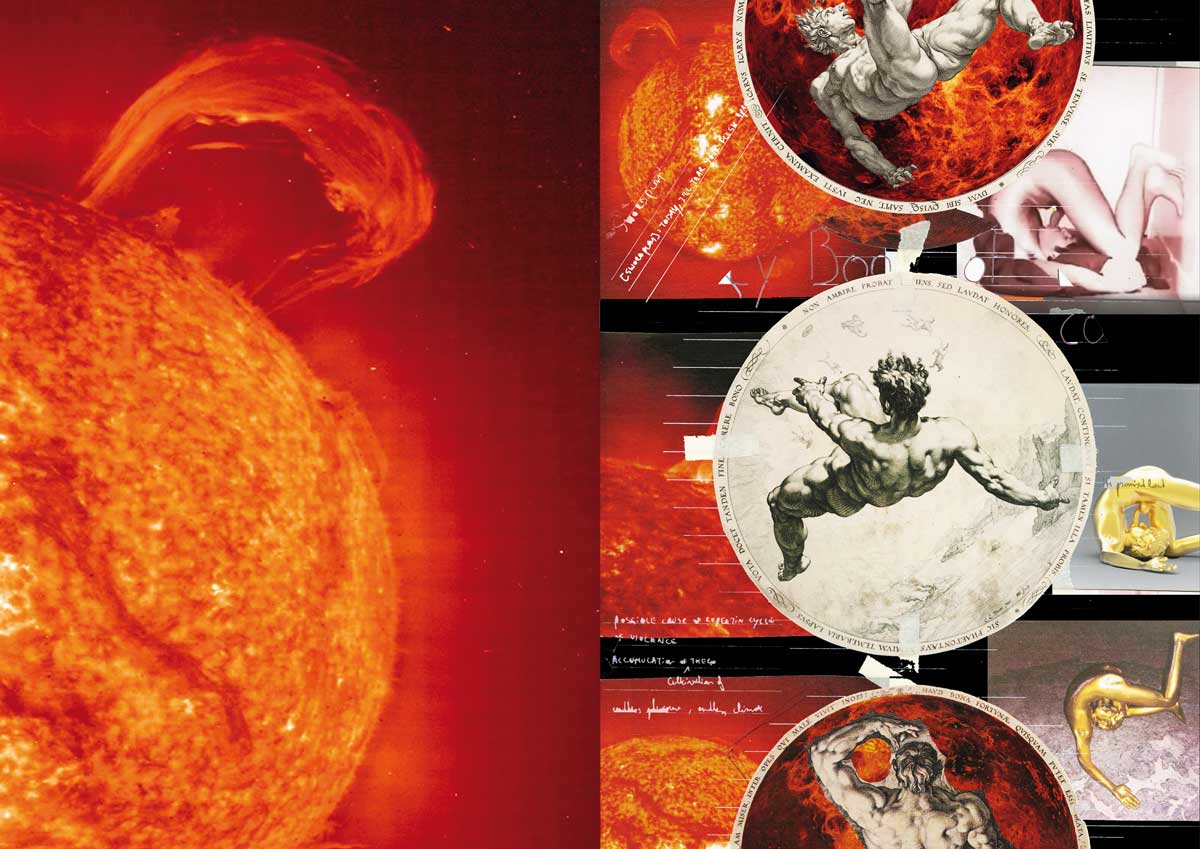
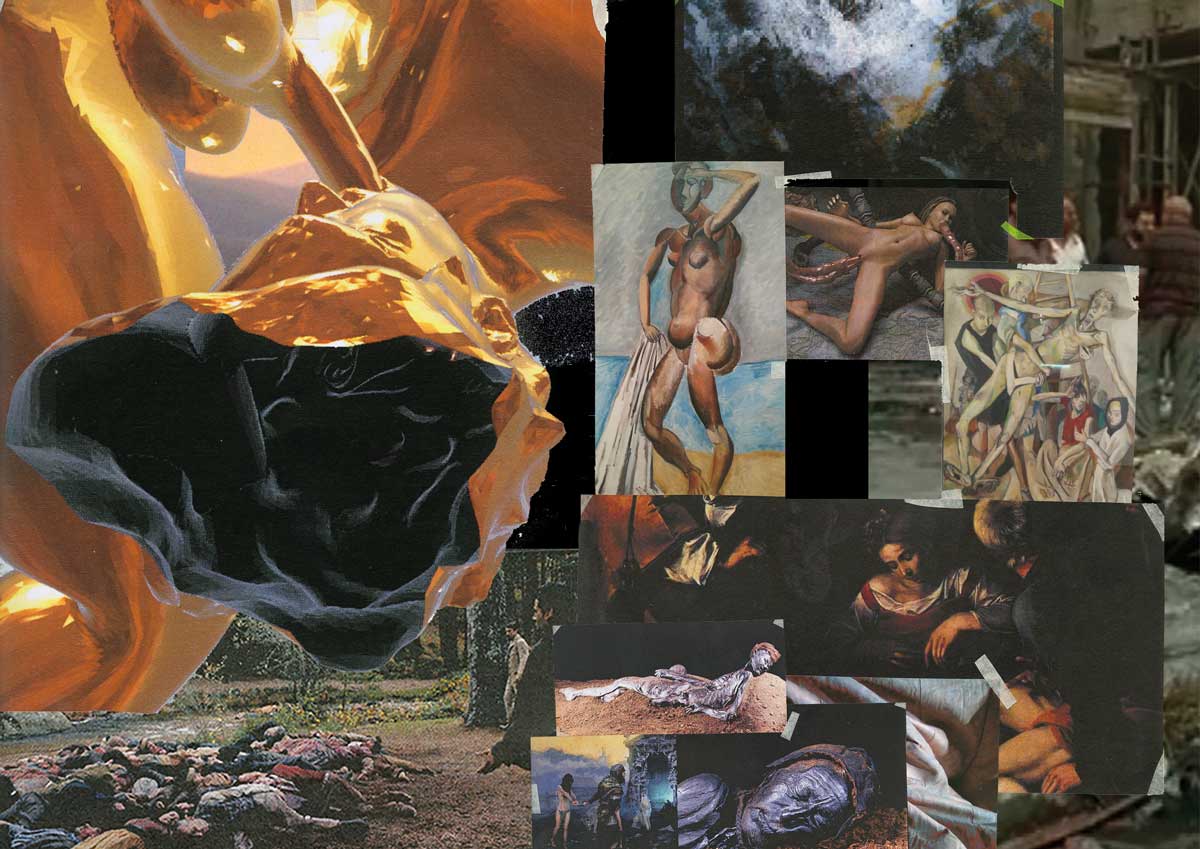
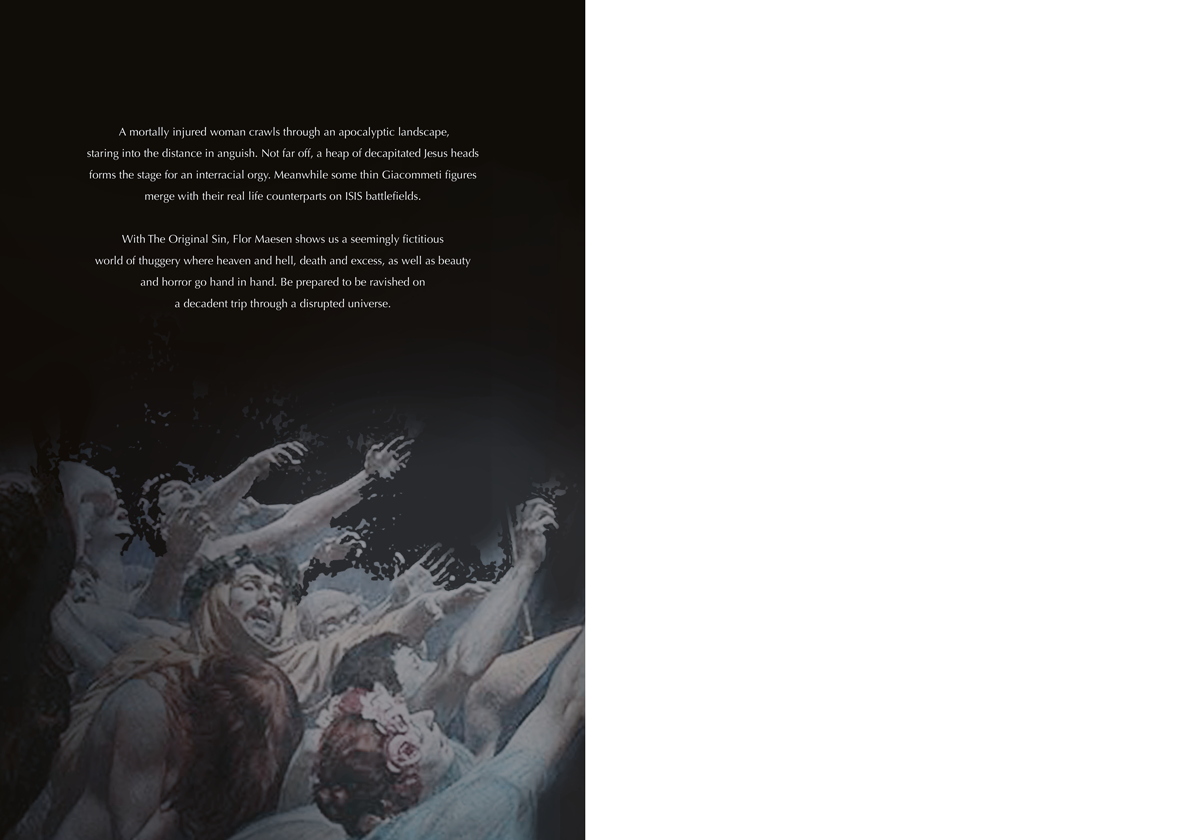
d
clustered | unclusteredThe Weird and the Queer
Alison Sperling
I. Introduction
In 2017, the journal Paradoxa published a special issue titled “Global Weirding,” a term named about a decade ago by New York Times journalist Thomas Friedman.1 The goal of the issue was in part to re-mobilize the concept as a “cognitive frame” which the editors claim could perhaps “refocus our attention on the localities within the totality of the global.”2 But the editors worry in their introduction that “global weirding” as a term might fail at the level of capturing what is already a life-or-death state of affairs. They write: “weird seems fun, quirky, almost cute ... and relatively innocuous, and in that way woefully inadequate to the scale of a crisis that threatens, for instance, the ongoing, still-unexplained mass death of bees ... or an ocean that is now predicted by some ecologists to be without fish life altogether by midcentury” (italics mine). While I might disagree somewhat (as a literary scholar) with the “innocuous” nature of the weird as a literary-historical genre or mode, I cite this as a provocation to think of weirdness as activating a kind of queer quirkiness (though I will push this more in the direction of perversity) and to question whether this is useful or ethical to do in relation to the seriousness and scale of the problems presented by the Anthropocene.
The articles in this cluster articulate some of the possible ways of interpreting or mobilizing the weird in relation to the current geological epoch of the Anthropocene, but for me a few keys points are worth making at the start to situate my continued interest in the weird: namely that the weird, for my purposes, suggests a kind of willful and unruly corporeality, an often fatalistic (temporally future-obsessed) sense of dread over becoming, of transformation, of finding in oneself (following Mark Fisher) that the outside is and has already been within.3 In contemporary weird fiction like Jeff VanderMeer’s, I’m especially interested in thinking about this kind of embodiment through critical approaches to toxicity and the ways that toxic corporeality comes to define the body in the Anthropocene in varied, and, of course, uneven ways. Being careful not to undermine the very real violence that toxicity presents through environmental racism and what Rob Nixon calls “slow violence,” I also want to follow certain queer and feminist thinkers, who wonder about a possible erotics or intimacy of toxicity that we might think of under or altered by the concept of a “weird” embodiment.4
In 2016 one of the top definitions of “weird” from The Urban Dictionary reads: “1. adj. u would call someone who is strange 2. (better definition) horny/kinky.” At the risk of thinking too seriously about The Urban Dictionary, I want to consider the weird and/in the Anthropocene through the queer. If queer theory has helped to show how sexual desire and gender norms continue to be destabilized in response to the events of the Anthropocene, how might the changing contours of desire and its relation to certain forms of power(lessness?) pervert or kink the emergent forms of “kinship” and new forms of intimacy supposedly ushered in with the Anthropocene and named as such by feminism, trans and queer theory as of late?5
Bracketing for the sake of time this large and varied body of work in the studies of queer toxicity, let it suffice to say that it has convincingly demonstrated that there is no living body on Earth free of microplastics, PCBs, silica, or radiation to name just a few examples, thus making so-called “toxicity” not an anomaly or thing one can avoid “out there,” but rather marking it as the ever-increasing norm. As Malin Ah-King and Eva Hayward write in 2014: toxicity “is not a root-bound forecast—disaster does not await us—rather it is a reminder that we are already living in ruination.”6 Though outside of the scope of this short paper, it is worth asking further what constitutes “ruination” for Ah-King and Hayward, and to what extent toxicity and ruination have been the bodily norm for a much longer evolutionary time.7
II. The Queer and the Weird
Queer theory has already made hugely important contributions to the varied discourses of the Anthropocene. In addition to challenging capitalist and colonialist legacies of modes of production, consumption, and reproduction, queer theorists have questioned narratives of progress especially in the name of (white, hetero) futurity. Queer theories of loss, shame, and grief have also been increasingly important for thinking about what might be framed as a form of climate trauma, geotrauma, feeling environmentally blue, or experiencing environmental grief.8 In addition, queer theorizing of mourning both in the present state of loss that many already find themselves in, as well as a kind of future-mourning for continued loss as a result of climate change of peoples and cultures, biodiversity, resources, etc., has therefore dealt with the letting go of the kind of future that “we” may have had before climate crisis came even more sharply into (popular) focus in the 21st century. Alongside black and indigenous studies, queer theory has especially questioned the very category of “the human” in an epoch named after the primacy of human actors on the planet, working to forge new, queerer alliances, intimacies, kinships with other-than-human-beings.
Is it helpful to think about the body and its non-humanness, including its nonhuman intimacies (some welcome, many not), as weird-ed in the Anthropocene, as already and continually transformed in an ever-toxic world? Following the work of Ah-King and Hayward, Mel Y. Chen, Michelle Murphy, Heather Davis, Alexis Shotwell and others, how can we think the toxic changed body in a way that both recognizes the uneven ways in which environmental toxicity is experienced but also refuses to reassert a politics of purity?9 To go even further, how might we understand shifting conceptions of sexuality, desire, and gender in relation to the various forms of weird embodiment ushered in with environmental toxicity in the Anthropocene?
I admit to being initially drawn to “the weird,” by which I mean thinking weirdness as a concept, because it seemed also so queer. Not only do the words share a particular aural quality between them, they have also long been used interchangeably, marking difference but more specifically marking moments when something is impossible to explain: “It’s so very queer” or “how weird.” Eve Sedgwick in a well-known passage writes of the queer that it is a “the open mesh of possibilities, gaps, overlaps, dissonances and resonances, lapses and excesses of meaning when the constituent elements of anyone’s gender, of anyone’s sexuality aren’t made (or can’t be made) to signify monolithically.”10 Queer is, according to Sedgwick, both “relational” and “strange.” And theorists of the weird have in a similar way pointed to its etymology in “twisting or bending.” I like the idea of thinking the queer and the weird together, I think they share the sense of meandering, being diverted; they both point away from teleological conceptions about life and futurity, they both seem to welcome being led astray…
Certainly this is also one of the reasons that a term like “Global Weirding” is effective (if it is): it gets at the unpredictability, the failure of existing tools and technologies to forecast the future of ever-weirder weather events and other climate-related catastrophes. Weird feels more and more like the way to describe the experience of living in the so-called Anthropocene, with constant announcements of doomsday climate scenarios, shocking rates of loss of biodiversity, rising sea levels and ocean acidification, not to mention the rising temperature of the planet; we all know some end is near but we don’t yet know exactly how near, nor can we fully predict what “it” will look like and for whom. But maybe there is also some pleasure, new forms of weird desire and kinship to be found on this meandering path.
III. Area X
“I am not returning home,” the no-longer-the-biologist writes in her last journal entry lines that close Jeff VanderMeer’s 2014 novel Annihilation.11 Recognizing that she is no longer who she once was, transformed because of the inexplicable landscape of Area X, she will decide to stay. What does it mean to choose to stay with the toxic?
In the days (or has it been weeks, months?) after the moment of her contamination by the inhalation of a strange kind of spore, the biologist describes her changing relationship to the world:
The wind picked up, and it began to rain. I saw each drop fall as a perfect, faceted liquid diamond, refracting light even in the gloom, and I could smell the sea and picture the roiling waves. The wind was like something alive; it entered every pore of me and it, too, had a smell, carrying with it the earthliness of the marsh reeds. I had tried to ignore the change ... but ... I was adapting to it.12
Her senses and awareness heightened, she describes being able to see and smell and hear the elements as if “something alive ... entered every pore” of her body. She writes a few pages later:
I walked silent and alone ... It was as if I traveled through the landscape with the sound of an expressive and intense aria playing in my ears. Everything was imbued with emotion, awash in it, and I was no longer a biologist but somehow the crest of a wave building ... the strange quality of the light upon this habitat ... the sense of waiting, brought me halfway to a kind of ecstasy.13
The passage builds to a “kind of ecstasy” where the biologist loses herself in what she describes as a “crest of a wave building,” in what I read as an erotic encounter with the nonhuman world. Able to feel (“everything was imbued with emotion”) the landscape and its newfound strangeness, she is brought almost to the height of pleasure even while walking silent and alone. Her intoxication leads her to experience her body and its enmeshment with the world differently and more thoroughly through emotion and even through pleasure.
Queer theory has a particular history of response and engagement with toxic desire and crises.14 What I’m drawn to in this body of work that I also find in the VanderMeer text is a kind of negotiation or ambiguity circulating around queer toxicity. For Mel Y. Chen, for example, living with MCS (multiple chemical sensitivity) renders them sometimes too sick to leave the house. But in a section of their book Animacies titled “Lead,” Chen describes an episode where they are couch-ridden with toxic sickness and in a haze, when they believe they may have mistaken their girlfriend for the couch, talking to it, running their finger “along a slip of fabric ever so slightly.”15
Chen continues in a passage worth quoting at length:
My care for a couch may well have stemmed from what some deem pathology, but that does not invalidate it as a peculiar [weird?] kind of care that may at least truck with the more intensive valence that a couch acquires ... Radical affection does not require intentional politics; and subjectivity itself, with its attendant danger zones of nationalism, individualism, whiteness, and rather anti-animate preference for typology and judgment, need not be core to this account... . Animacy ... is here and ... it has its own regulatory forces which must be accounted for and met ... it remains eminently possible for us to seek out and affirm the wiliness within.”16
Asking what new forms of intimacy are rendered possible or even necessary in an increasingly toxic world, Chen and a growing number of other queer and feminist theorists of the so-called Anthropocene have considered the inanimate, the (nonhuman) animal, the vegetal, and other bodies that become perhaps intimately charged in new ways through contamination. Chen calls this “radical affection,” which neither celebrates nor denigrates the toxic self but looks instead to see what new forms of attachment might be made possible through the toxic. VanderMeer’s Southern Reach trilogy is perhaps an exploration of both radical affection and what Chen describes as “the wiliness within” the body, as the short passages I’ve quoted above from the trilogy hopefully begin to demonstrate here. In a way not unrelated to Chen’s experience, the biologist faces her newly embodied state with ambiguous responses, not particularly attached to the person she was before the toxic moment and even feeling invigorated and stimulated by the new ways she is able to experience the world precisely as a result of her contamination.
Because I am working on a new project on weird spaces including radioactive zones, I can’t help but also think of Area X as a kind of exclusion or alienation zone, a place so toxic and so uncontainable that its borders shift and become impossible to map clearly. And like the biologist in Annihilation there are increasing cases of people embracing, or at least challenging what it means to be a toxic body.17 Surely not all toxic forms of embodiment are weird nor can toxicity be generally thought of as a queer state. But what I hope that this article suggests is that thinking the discourse of queer toxic embodiment alongside weird fiction allows speculation about shifting conceptions of what constitutes the boundaries of the body and its intimate attachments in the Anthropocene. Moreover, this particular confluence of theory and fiction can continue to probe Donna Haraway’s oft-cited but also perhaps often overly simplified suggestion that we “stay with the trouble.” In relating to the trouble, to the toxic, what might it mean (politically, corporeally, sexually, as a gendered and raced body, etc.) to choose, or even want to dwell there?
Notes
- 1See Gerry Canavan and Andrew Hageman, “Introduction,” Paradoxa 28 (2016) and Thomas Friedman, “Global Weirding is Here”
- 2Canavan and Hageman, “Introduction,” 8.
- 3See Mark Fisher, The Weird and the Eerie (London: Repeater Books, 2017).
- 4See Rob Nixon, Slow Violence and the Environmentalism of the Poor (Cambridge, MA: Harvard University Press, 2011).
- 5See Donna Haraway’s Staying with the Trouble: Making Kin in the Chthulucene (Durham, NC: Duke University Press, 2016), but also scholarship on new forms of intimacy with nonhumans (animals, plants, pharmaceuticals, chemicals, bacteria).
- 6Malin Ah-King and Eva Hayward, “Toxic Sexes: Perverting Pollution and Queering Hormone Disruption,” O-Zone: A Journal of Object-Oriented Studies 1: Object/Ecology (2013): 2.
- 7Thanks to Marco Caracciolo for suggesting this point.
- 8See Eileen Joy’s essay “Blue” in Jeffrey Jerome Cohen, ed., Prismatic Ecology: Ecotheory beyond Green (Minneapolis: University of Minnesota Press, 2013), 213-32. See also E. Ann Kaplan, Climate Trauma: Foreseeing the Future in Dystopian Film and Literature (New Brunswick, NJ: Rutgers University Press, 2015) and Robin MacKay’s helpful “A Brief History of Geotrauma”
- 9See Mel Y. Chen, Animacies: Biopolitics, Racial Mattering, and Queer Affect (Durham, NC: Duke University Press, 2012); Nancy Tuana, “Viscous Porosity: Witnessing Katrina,” in Material Feminisms, ed. Stacy Alaimo and Susan J. Hekman (Bloomington: Indiana University Press, 2008), 188-213; Heather Davis, “Toxic Progeny: The Plastisphere and Other Queer Futures,” philoSOPHIA 5, no. 2 (2015): 231-50; Alexis Shotwell, Against Purity: Living Ethically in Compromised Times (Minneapolis, University of Minnesota Press, 2016), amongst many other examples of critical toxicity studies.
- 10Eve Kosofsky Sedgwick, Tendencies (Durham: Duke University Press, 1993), 8.
- 11Jeff VanderMeer, Annihilation (Basingstoke: Macmillan, 2014), 128.
- 12VanderMeer, 50.
- 13VanderMeer, 59.
- 14See, for example, Leo Bersani’s work in response to the HIV/AIDS crises in 1987 (“Is the Rectum a Grave?” October 43 (1987): 197–222), but also more recently Paul Preciado’s work on pharma-toxicity (Beatriz Preciado, Testo Junkie: Sex, Drugs, and Biopolitics in the Pharmacopornographic Era, New York: The Feminist Press at Cuny, 2013), Neel Ahuja’s work on toxic atmospheres (“Intimate Atmospheres: Queer Theory in a Time of Extinctions,” GLQ 21, no. 2-3 (2015): 365-85), and Mel Chen’s Animacies, which I engage in this essay.
- 15Chen, Animacies, 237.
- 16Chen, Animacies, 237.
- 17I’m thinking here of “The Woman who Ate Chernobyl’s Apples” who documents her expeditions in radioactive exclusion zones on Youtube, but also of the concept of “mutant subjectivity” developed by Joseph Masco and Magdalene Stawkowski, the latter of which has an article about a small community near Kazakhstan’s Semipalatinsk nuclear test site that embraces the possibility of their own “mutation” and believes that only by staying in this toxic zone they can survive. See Masco, The Nuclear Borderlands: The Manhattan Project in Post-Cold War New Mexico (Princeton, NJ: Princeton University Press, 2006), and Magdalena E. Stawkowski’s “‘I Am a Radioactive Mutant’: Emergent Biological Subjectivities at Kazakhstan’s Semipalatinsk Nuclear Test Site,” American Ethnologist 43, no. 1 (2016): 144-57.

